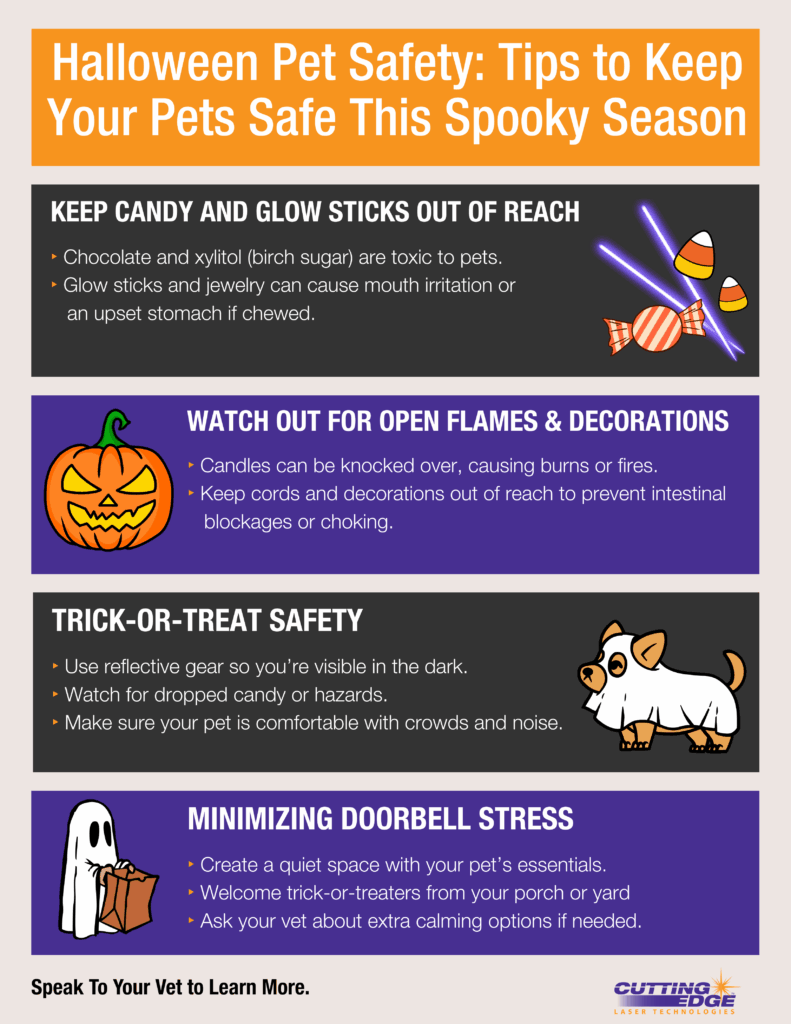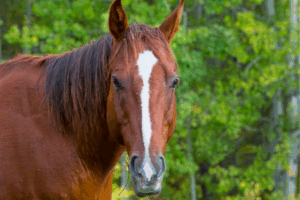Halloween is a time of excitement and celebration, but it can also pose unique risks for our furry family members. Between tempting treats, flickering candles, and the constant sound of the doorbell, even the calmest pets may find the night stressful or hazardous. With some planning and awareness, pet owners can help their companions enjoy a safe and happy holiday.
Why Pet Safety on Halloween Matters
Each Halloween, veterinarians see a spike in pet emergencies, from candy ingestion to stress-related injuries. Pet Poison Helpline reports that chocolate toxicity remains one of the top reasons for calls to poison control during the holiday. If ingestion is suspected, contact your veterinarian or the ASPCA Animal Poison Control Center (888-426-4435) right away. The Humane Society of the United States adds that pets are more likely to become lost or injured due to constant visitors, open doors, and unfamiliar sights and sounds.
Common Halloween Hazards and How to Prevent Them:
Keep Glow Sticks Out of Reach
According to the AVMA, even “low-toxicity” items like glow sticks and decorations can lead to clinic visits for drooling, mouth irritation, or choking hazards. Pets that bite into them may begin drooling, pawing at their mouth, or refusing food. Always dispose of used glow products immediately after use.
Hidden Toxins in Halloween Treats
The AKC warns that xylitol, often labeled as birch sugar, is highly toxic to dogs, causing dangerous drops in blood sugar and even liver failure. Chocolate and raisins are also hazardous for pets, and even small amounts of these treats can cause vomiting, diarrhea, tremors, or seizures. Keep all treats stored in sealed containers and well out of reach, and remind children not to share candy with pets.
Watch Out for Open Flames and Decorations
Halloween decorations are festive but can pose real hazards for curious pets. Candles placed inside pumpkins or on tables can easily be tipped over by wagging tails or excited movements, resulting in burns or fires. Consider switching to battery-operated candles to eliminate this risk.
Electrical cords, fake cobwebs, and small hanging decorations can also be problematic if chewed or swallowed. These items can lead to electric shock, choking, or intestinal blockage. Always secure decorations out of your pet’s reach and supervise them around new objects.
Trick-or-Treating Safety
If you plan to bring your dog trick-or-treating, take extra precautions. Equip your dog with a reflective collar, leash, or vest so they’re visible to drivers and pedestrians after dark. Keep them close and be mindful of dropped candy or wrappers along sidewalks.
Before heading out, evaluate your dog’s comfort level with crowds, costumes, and noises. Not all pets enjoy the excitement of trick-or-treating, and for those who are anxious or easily startled, staying home in a secure environment is usually the best option.
Minimizing Doorbell and Visitor Stress
The constant ringing of the doorbell and parade of strangers in costumes can overwhelm pets. To help them stay calm, create a safe, quiet space away from the front door. Place familiar items such as their bed, toys, and water bowl in the room to provide comfort. To minimize doorbell stress, sit outside to hand out candy.
You can also close blinds, lower the lights, and play calming music or white noise to block outside distractions. For pets prone to severe anxiety, ask your veterinarian in advance about behavioral strategies, pheromone diffusers, or calming supplements that might help during the evening.
Costume Caution
Dressing up pets for Halloween can be fun, but it’s important to prioritize their safety and comfort. Choose costumes that fit well without restricting movement, breathing, or vision. Avoid materials that could cause overheating or irritation.
Inspect costumes for small parts, such as buttons or bells, that could become choking hazards if chewed. Introduce the costume slowly, let your pet sniff and explore it before wearing, and watch for signs of discomfort such as flattened ears, panting, or reluctance to move. If your pet seems uneasy, skip the costume altogether.
Put the Tips Into Action with Our Infographic
To make it even easier to keep your pets safe this Halloween, check out the infographic at the bottom of this article. It’s a handy, visual summary of all the key safety tips we’ve covered, from candy hazards to doorbell stress. You can print it out to share with your clients or post it in your clinic, or share it on your social media to help fellow pet owners keep their furry friends safe this spooky season.





